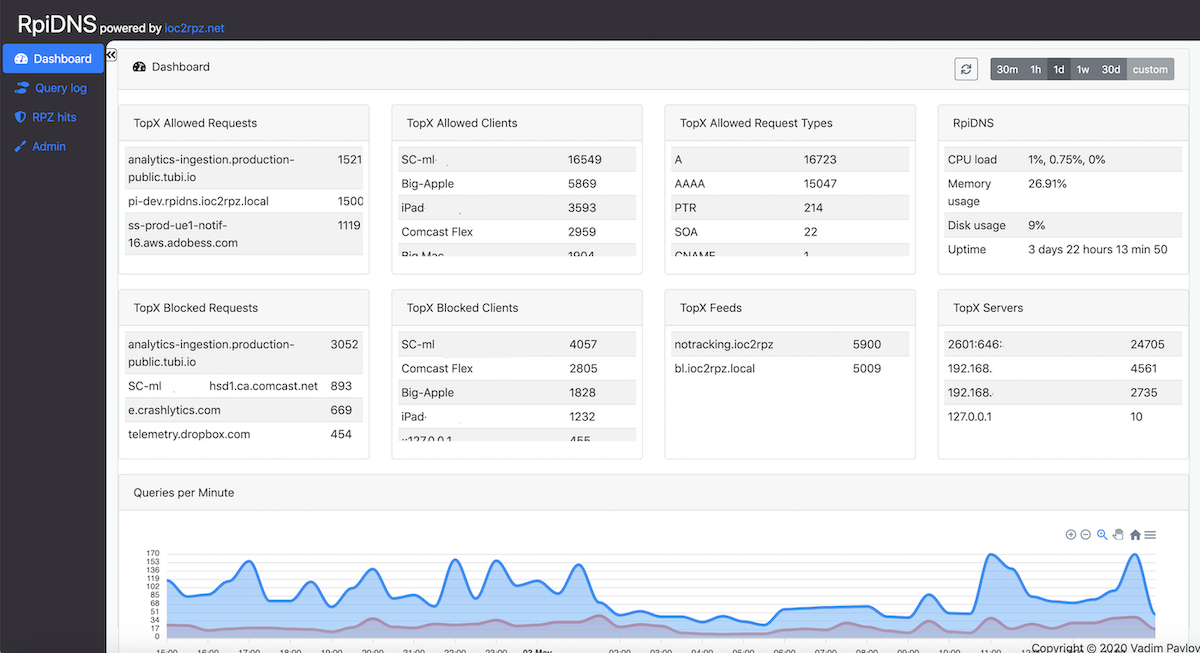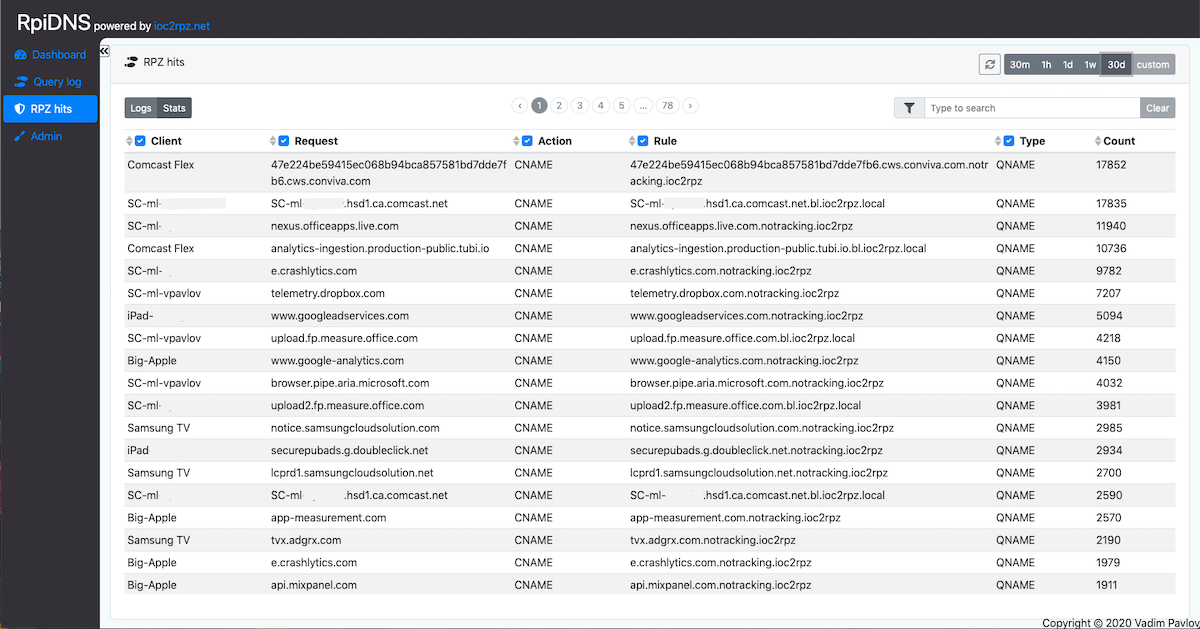RpiDNS on the ioc2rpz community web-site provides simplified configuration interface and an installation script to provision DNS security at your home, office or home office.
The RpiDNS project on github is a web-interface for RpiDNS. It can be used with a standalone ISC Bind instance. In that case some configuration changes may be required on ISC Bind side and/or RpiDNS.
Reporting period is defined by a selector located in top right corner. You can select:
- 30m - 30 minutes;
- 1h - 1 hour;
- 1d - 1 day;
- 1w - 1 week;
- 30d - 30 days;
- custom (not implemented). Depending on the period different tables will be used. 30m and 1d based on raw log messages, other reports on a mix of raw data and aggregated data (per 5 minutes, 1 hour, 1 day).
Widgets on the dashboard and reports offers various tools depending on the context. From the dashboard you can drill-down to the reports by using "show queries" or "show hits" tools. A relevant report will be opened with a defined filter based on data type in a widget.
For threat hunting, investigation of false positives RpiDNS offers multiple research tools. When you click on a tool a new browser window is opened and an indicator is passed to a 3rd party web-site.
The research tools include:
- DuckDuckGo - search engine concerned about privacy;
- Google - generic search engine;
- VirusTotal - service which allows to validate if a domain, IP, URL, file, file hash is malicious or not.
- RiskIQ Community - service which provides access to passive DNS data and other digital footprint (PassiveTotal and Digital Footprint community editions).
- DomainTools Whois - domain and IP registration information.
- Robtex - provides public information about IP numbers, domain names, host names, Autonomous systems, routes etc.
- Apility.io - threat intelligence SaaS for developers and product companies that want to know in realtime if their existing or potential users have been classified as 'abusers' by one or more of these lists.
- ThreatMiner - ThreatMiner is a threat intelligence portal that provides information on indicators of compromise (IOC) such as domains, IP address, malware samples etc.
The widget shows topX DNS requests which were not blocked.
The widget shows topX clients which requests were not blocked.
The widget shows topX request types (e.g. A, AAAA, MX).
The widget shows information about RpiDNS: CPU utilization, Memory utilization, Disk utilization, Uptime, GPU temperature
The widget shows topX DNS requests which were blocked.
The widget shows topX clients which requests were blocked.
The widget shows topX feeds which were used to block requests.
The widget shows information about total number requests received by a DNS server (per IP) per reporting period.
Query log report provide information about all DNS queries received by RpiDNSs in your network.
You can switch between raw logs ("Logs" switch) and statistics ("Stats" switch). On the statistics table there is no time field and you can check/uncheck fields used for aggregation. The report has the following fields:
- Local time - time in your timezone. RpiDNS should be configured with UTC timezone. Requests are aggregated by 5 minutes, 1 hour, 1 day;
- Client - client name or IP if the client was not registered;
- Server - server IP;
- Request - requested fqdn;
- Type - request type;
- Class - request class;
- Options - request options;
- Count - number of requests aggregated in a single record;
- Action - action taken: Allow or Block.
RPZ hits report provide information about blocked requests.
You can switch between raw logs ("Logs" switch) and statistics ("Stats" switch). On the statistics table there is no time field and you can check/uncheck fields used for aggregation. The report has the following fields:
- Local time - time in your timezone. RpiDNS should be configured with UTC timezone. Requests are aggregated by 5 minutes, 1 hour, 1 day;
- Client - client name or IP if the client was not registered;
- Request - requested fqdn;
- Action - performed action e.g. NXDOMAIN, CNAME (redirect) etc;
- Rule - rule which was used to block the request. If i was a wildcard rule a full fqdn will be shown. The rule also contains a feed name;
- Type - rule type. E.gg. QNAME means blocked by a requested hostname/domain.
- Count - number of requests aggregated in a single record.
On this tab you can define you assets. Depending on the settings assets can be tracked by IP or MAC address. RpiDNS doesn't have integrations with DHCP servers and can track MAC addresses only in the same LAN (arp). For home users it is usually not an issue but provide you flexibility to track a device even if it changes an IP. The device names are used on the dashboard and in the reports.
Blacklist is a local response policy zone which is used to block/redirect requests to defined domains/fqdns. To generate wildcard rules - toggle "include subdomains". You may enable/disable individual rules.
Whitelist is a local response policy zone which is used to allow requests to defined domains/fqdns in case if there is a false positive in the feeds. To generate wildcard rules - toggle "include subdomains". You may enable/disable individual rules.
On this tab you can:
- define data retention policy;
- enable/disable automatic assets creation;
- define how to track assets (IP or MAC);
- define maximum entries for dashboards.
Download tab contains allow you to download:
- bind log files;
- the RpiDNS Database;
- a local root CA certificate. You need to install the certificate on your devices if you want to avoid "SSL Error" warnings in browsers if a request was blocked.
It is an installation script. It pulls required libraries, tools, packages (except a web-server), copy files to directories, init the database and setup crontab tasks. It was written for Raspbian, other Linux distribution currently are not supported but you can easily update it.
The DB initialization script.
The script is executed by crontab and removes old log messages from the DB. The DB is cleaned up by native sqlite3 "VACUUM" command.
The script parses bind's query and rpz log files, saved logs in the DB and performs data aggregation. The script is executed by cron every minute.
To work with RpiDNS ISC Bind should:
- export DNS queries and RPZ hits into a log-file
- local RPZs: wl.ioc2rpz.local, wl-ip.ioc2rpz.local, bl.ioc2rpz.local, bl-ip.ioc2rpz.local
You can support the project via GitHub Sponsor (recurring payments) or make one time donation via PayPal.
You can contact us by email: feedback(at)ioc2rpz[.]net or in Telegram.
Copyright 2020 Vadim Pavlov ioc2rpz[at]gmail[.]com
Licensed under the Apache License, Version 2.0 (the "License"); you may not use this file except in compliance with the License. You may obtain a copy of the License at
http://www.apache.org/licenses/LICENSE-2.0
Unless required by applicable law or agreed to in writing, software distributed under the License is distributed on an "AS IS" BASIS, WITHOUT WARRANTIES OR CONDITIONS OF ANY KIND, either express or implied. See the License for the specific language governing permissions and limitations under the License.




